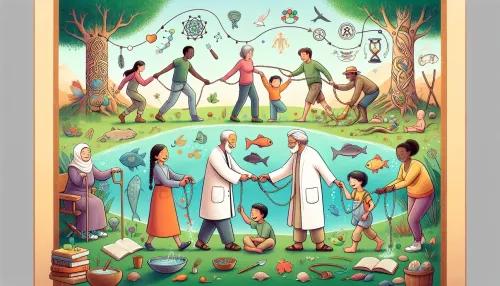
Innovative Legacy: Preserving Time-Honored Practices While Embracing Technological Advancements

Autism care has long been a domain where time-honored practices play a crucial role in supporting individuals on the spectrum. However, with the rapid advancements in technology, there's an increasing need to integrate traditional therapies with modern techniques to provide comprehensive and effective support for autistic children. The HorizonsMind Blog explores the innovative legacy of preserving ancient practices while embracing technological advancements, aiming to strike a harmonious balance for sustainable progression and long-term well-being.
Adapting Traditional Therapies: Integrating Ancient Practices with Modern Techniques in Autism Care
In the realm of autism care, traditional therapies such as sensory integration, behavioral therapy, and social skills training have been instrumental in fostering the development and well-being of autistic children. These time-honored practices are rooted in understanding and addressing the unique needs of individuals on the autism spectrum. However, the evolution of autism care has paved the way for integrating these traditional therapies with modern techniques to enhance their effectiveness.
The integration of traditional therapies with modern techniques involves leveraging evidence-based approaches that are backed by research and clinical experience. For instance, combining traditional sensory integration activities with virtual reality technology can create immersive environments tailored to meet the sensory needs of autistic children while offering a novel and engaging sensory experience. By adapting traditional therapies to incorporate advancements like assistive technology and telehealth services, caregivers and therapists can extend support beyond clinical settings, ensuring continuous care and progress monitoring.
Wisdom of the Past, Tools of the Future: Utilizing Age-Old Insights Combined with Cutting-Edge Technologies
The wisdom embedded in traditional practices holds invaluable insights into understanding and meeting the diverse needs of autistic children. These age-old insights encompass holistic approaches that consider the individual's strengths, challenges, and sensory sensitivities. While honoring these longstanding principles, it is equally essential to harness cutting-edge technologies to tailor interventions and support strategies effectively.
By merging age-old insights with contemporary technologies, such as artificial intelligence (AI) and machine learning, caregivers and therapists can gain deeper insights into the unique behavioral patterns, preferences, and responses of autistic children. This empowers them to personalize interventions, communication approaches, and learning materials according to individual needs, thereby fostering a more effective and inclusive support system.
Moreover, leveraging wearable devices equipped with biofeedback mechanisms can enable real-time monitoring of stress levels and emotional regulation in autistic children, facilitating timely interventions and tailored support. This seamless integration of wisdom from the past with tools of the future not only ensures a nuanced understanding of the individual but also fosters an environment conducive to holistic development and well-being.
Digital Preservation of Heritage: Ensuring Cultural Continuity alongside Technological Innovations in Autism Support
Cultural heritage plays a significant role in shaping the identity and experiences of individuals within communities. For autistic children, cultural continuity not only fosters a sense of belonging but also serves as a source of comfort and familiarity. Thus, as technological innovations continue to redefine autism support, it is imperative to preserve cultural heritage digitally to ensure its seamless incorporation into interventions and support systems.
Digital preservation efforts encompass creating inclusive digital resources that encapsulate cultural elements significant to autistic children. These resources can range from interactive storytelling platforms rooted in cultural narratives to virtual exhibits highlighting traditional art forms and practices. By digitizing heritage through immersive multimedia experiences, autistic children can engage with their cultural roots in a manner that aligns with their sensory preferences while fostering a sense of pride and connection.
Furthermore, technological innovations enable the creation of assistive communication tools that are linguistically and culturally attuned to diverse communities. By preserving cultural heritage digitally and integrating it into assistive technologies, caregivers and therapists can enhance communication experiences for autistic children within the framework of their cultural identities, promoting a supportive environment that respects individual diversity.
Sustainable Progression: Balancing Tradition and Innovation for Long-Term Autistic Well-Being
As we navigate the intersection of tradition and innovation in autism care, it becomes evident that a harmonious balance between time-honored practices and technological advancements is essential for sustainable progression towards long-term well-being for autistic children. By embracing innovation while preserving traditional wisdom, we pave the way for sustainable progress that honors individual diversity, leverages cutting-edge interventions tailored to specific needs, and ensures cultural continuity within supportive frameworks.
The quest for sustainable progression involves not only integrating ancient practices with modern techniques but also fostering collaborative partnerships between community stakeholders – including caregivers, therapists, educators, and technology developers – to co-create inclusive solutions rooted in empathy and evidence-based approaches. This collective endeavor fosters an ecosystem wherein tradition informs innovation while innovation enriches tradition, ultimately paving the way for sustained well-being and holistic development within the autism community.
In conclusion, the innovative legacy of preserving time-honored practices while embracing technological advancements encapsulates a transformative approach toward autism care – one that harmonizes cherished traditions with progressive innovations to nurture sustainable progression and long-term well-being for autistic children.
Considering its vital intersection between tradition and innovation, addressing both practical applications while drawing on age-old wisdom is crucial for nurturing all-encompassing support systems for autistic children. The article effectively balances technical insights with actionable strategies that resonate with newcomers as well as veterans in the field.
Check Out These Related Articles


Honoring Traditions: Integrating Time-Honored Wisdom into Modern Autism Care

Harmonizing Paints and Potions: Exploring the Interplay of Art and Therapeutic Science for Autistic Children
